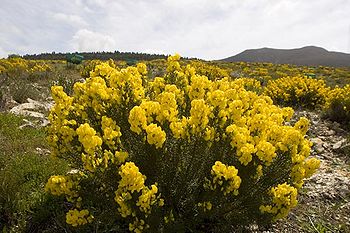Honeybush
Other Names : Cyclopia Intermedia, Cyclopia subternata, Cyclopia pubescens, Cyclopia meyeriana, Heuningtee, Bergtee, Boertee, Bossiestee, Bushtea
Honeybush (Cyclopia spp.) is indigenous to the cape of South Africa. It is used to make a beverage and a medicinal tea, having a pleasant, mildly sweet taste and aroma, somewhat like honey. It has become internationally known as a substitute for ordinary tea (Camellia sinensis). With the dramatic growth in the use of honeybush during the past five years, export of honeybush tea products is now a major industry, following up on the success of another tea substitute from South Africa : Rooibos. Commercial supplies of honeybush are mainly obtained from Cyclopia intermedia and to a lesser extent from Cyclopia subternata, though there are about 2 dozen species of Cyclopia identified in this narrow region of South Africa. Most of the species have very limited distribution ranges and unique habitat preferences. Some are restricted to mountain peaks, perennial streams, marshy areas, shale bands, or wet southern slopes. Some of the species, such as Cyclopia maculata, Cyclopia genistoides, and Cyclopia sessiliflora, have been used for home consumption. It appears that all the Cyclopia species are suitable for making tea, but the taste quality can vary, and some species exist in very small quantities.
Special Precautions of Honeybush
Benefits and uses of Honeybush are
Honeybush tea is made as a simple herbal infusion. It is sometimes consumed with milk and sugar as is done with black tea, but to appreciate the delicate sweet taste and flavor, no milk or sugar should be added. Adding a small amount of honey to the tea will bring out the honey-like flavor of the herb. Descriptions of the honeybush flavor include hot apricot jam; floral, honey-like; and dried fruit mix. The overall impression is mild sweetness. The tea has the added advantage that the cold infusion can also be used as iced tea and that it blends well with fruit juices. The tea can be consumed daily, or can be rotated with other beverage teas, such as Rooibos and ordinary tea. For treatment of coughs, or as an aid in regulating blood sugar in diabetes, or helping reduce menopausal symptoms, the tea would be taken several times per day.
- One of its early recognized benefits as a tea substitute is its lack of caffeine, which makes it especially suited for nighttime consumption and for those who experience nervousness and want to avoid ordinary tea. As a result, it had a reputation as a calming beverage, though it may not have any specific sedative properties.
- It has very low tannin content and contains no caffeine. It is therefore especially valuable for children and patients with digestive and heart problems where stimulants and tannins should be avoided.
- The traditional use of the tea for treating cough may be explained, in part, by its content of pinitol, a modified sugar that is similar to inositol. Pinitol, named for its major source, pine trees, is also found in the leaves of several legume plants; it is an expectorant.
- Pinitol is also of interest for apparent blood-sugar lowering effects, as demonstrated in laboratory animal studies (it may increase the effects of insulin), and is being considered as a drug for diabetes.
- Honeybush also contains flavones, isoflavones, coumestans, luteolin, 4-hydroxycinnamic acid, polyphenols, and xanthones. These ingredients serve as antioxidants and may help lower blood lipids. The isoflavones and coumestans are classified as phytoestrogens, used in the treatment of menopausal symptoms, an application for which honeybush has recently been promoted. The flavones and isoflavones of honeybush are similar to those in soy, another leguminous plant, also used in treatment of menopausal symptoms.
- Cancer : Isovlavones and Coumestans show estrogenic activity and may be benificial for preventing breast, prostate and uterus Cancer.
- Luteolin is the primary yellow pigment of the flowers and has been used historically as a dye (most often obtained for this purpose from the plant called Dyer's Weld, Reseda luteola).
References
- Smith M, et al. (compilers), Honeybush, 2001 Agribusiness in Sustainable Natural African Plant Products (ASNAPP), Dennesig, South Africa.
- van der Walt L. Cyclopia genistoides, 2000 National Botanical Institute, South Africa [1].
- Bates SH, Jones RB, Bailey CJ, Insulin-like effect of pinitol, British Journal of Pharmacology 2000; 130(8): 1944-1948.
- Kamara BI, et al., Polyphenols from honeybush tea, Journal Agricultural Food Chemistry 2003; 51(13): 3874-3879.
- Marnewick JL, et al., Modulation of hepatic drug metabolizing enzymes and oxidative status by rooibos and honeybush, green and black (Camellia sinensis) teas in rats, Journal Agricultural Food Chemistry 2003; 51(27): 8113-8119.
- Chiechi LM, Dietary phytoestrogens in the prevention of long-term postmenopausal diseases, International Journal of Gynecology and Obstetrics, 1999; 67(1): 39-40.
